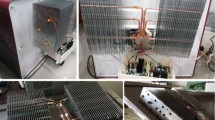Abstract
Optimum control of the PCB surface temperature is very important in achieving high performance and operational reliability of telecommunication equipment with high power density and thermal density. In this study, the performance of a liquid cooling unit with MPCM slurries (called as “MPCM cooled unit”) was tested and analyzed. In addition, its performance was compared with that of an air cooled unit and a water cooled unit. The maximum surface temperature and the index of uniform temperature distribution (IUTD) were introduced to analyze cooling performance. The surface temperature in the unit rack of telecommunication equipment can be controlled properly by using an MPCM cooled unit instead of an air cooled unit. The maximum surface temperature and IUTD of the MPCM cooled unit at the inlet temperature of 19°C were lower than those at inlet temperatures of 25°C and 27°C due to the increases of heat capacity and heat transfer rate. The heat capacity of the MPCM cooled unit increased significantly with the increase of mass flow rate due to high specific heat of MPCM particles with latent heat transfer rate. The cooling performance of the MPCM cooled unit was superior to that of the water cooled unit.
Similar content being viewed by others
References
R. R. Schmidt and H. Shaukatullah, Computer and telecommunications equipment room cooling: A review of literature, IEEE Transactions on Components and Packaging Technologies 26(1) (2003) 89–98.
H. Lee, Y. Jeong, J. Shin, J. Baek, M. Kang and K. Chun, Package embedded heat exchanger for stacked multi-chip module, Sensors and Actuators A. 114 (2004) 204–211.
R. J. McGlen, R. Jachuck and S. Lin, Integrated thermal management techniques for high power electronic devices, Applied Thermal Engineering 24 (2004) 1143–1156.
P. Cinato, C Bianco, L. Licciardi, F. Pizzuti, M. Antonetti and M. Grossoni, An innovative approach to the environmental system design for TLC rooms in Telecom Italia, INTELEC, (1998) 770–776.
M. Nakao, H. Hayama and T. Uekusa, An efficient cooling system for telecommunication equipment rooms, INTELEC, (1988) 344–349.
K. E. Gill, Telecom HVAC cool connections (HVAC in telecommunication facilities), HVAC Engineering. 73(1) (2001) 29–38.
C. C. Sullivan, Cooling data and dot-coms, Consulting-Specifying Engineering 29(1) (2001) 28–36.
G. Hetsroni, A. Mosyak, Z. Segal and G. Ziskind, A uniform temperature heat sink for cooling of electronic devices, International Journal of Heat and Mass Transfer 45(16) (2002) 3275–3286.
M. Choi and K. Cho, Liquid cooling for a multichip module using fluorinert liquid and paraffin slurry, International Journal of Heat and Mass Transfer 43 (2) (2000) 209–218.
G. Dumont, F. V. Roux and B. Righini, Water-cooled electronics, Nuclear Instruments & Methods in Physics Research A 440 (2000) 213–223.
H. Y. Zhang, D. Pinjala, T. N. Wong, K. C. Toh and Y. K. Joshi, Single-phase liquid cooled microchannel heat sink for electronic packages, Applied Thermal Engineering 25(10) (2005) 1427–1487.
H. Inaba, New challenge in advanced thermal energy transportation using functionally thermal fluids, International Journal of Thermal Science 19 (2000) 991–1003.
J. G. Lee, J. H. Kim, Y. C. Choi, S. H. Lee, Y. G. Kim, J. G. Choi, H. S. Han, W. M. Lee, H. S. Kim, Y. S. Shin, K. H. Kim, H. J. Lee and J. M. Choi, Development of high density thermal fluid and heat transportation technology, MOST Report M102KP-010001-03K1601-02410 KOSEF, Seoul, Korea (2005).
H. Hayama and M. Nakao, Air flow systems for telecommunications equipment rooms, INTELEC, (1989) 1–7.
J. S. Lock, E. Bertson and J. Boissevain, Air cooling of front-end electronics for silicon detectors in collider experiments, Nuclear Instruments and Methods in Physics Research A 345 (1994) 284–288.
C. W. Leung, J. J. Kang and S. D. Robert, Horizontal simulated printed-circuit board assembly in fully-developed laminar-flow convection, Applied Energy 56(1) (1997) 71–91.
J. L. Alvarado, C. Marsh, C. Sohn, G. Phetteplace and T. Newell, Thermal performance of microencapsulated phase material slurry in turbulent flow under constant heat flux, International Journal of Heat and Mass Transfer 50 (2007) 1938–1952.
Y. Yamagishi, H. Takeuchi, A. T. Pyatenko and N. Kayukawa, Characteristics of MPCM slurry as a heat transfer fluid, AIChE 45 (1999) 696–707.
J. Jeon, Y. Kim, J. M. Choi, H. Kang and D. Cheon, Performance comparison of liquid-cooling with air-cooling heat exchangers for telecommunication equipment, The 3rd Asian Conference on Refrigeration and Air-conditioning, Gyeongju, Korea. (2006) Paper No. 227.
Author information
Authors and Affiliations
Corresponding author
Rights and permissions
About this article
Cite this article
Choi, J., Jeon, J. & Kim, Y. Performance characteristics of a MPCM slurry cooled unit designed for telecommunication equipment. J Mech Sci Technol 22, 575–582 (2008). https://doi.org/10.1007/s12206-007-1212-5
Received:
Revised:
Accepted:
Published:
Issue Date:
DOI: https://doi.org/10.1007/s12206-007-1212-5




